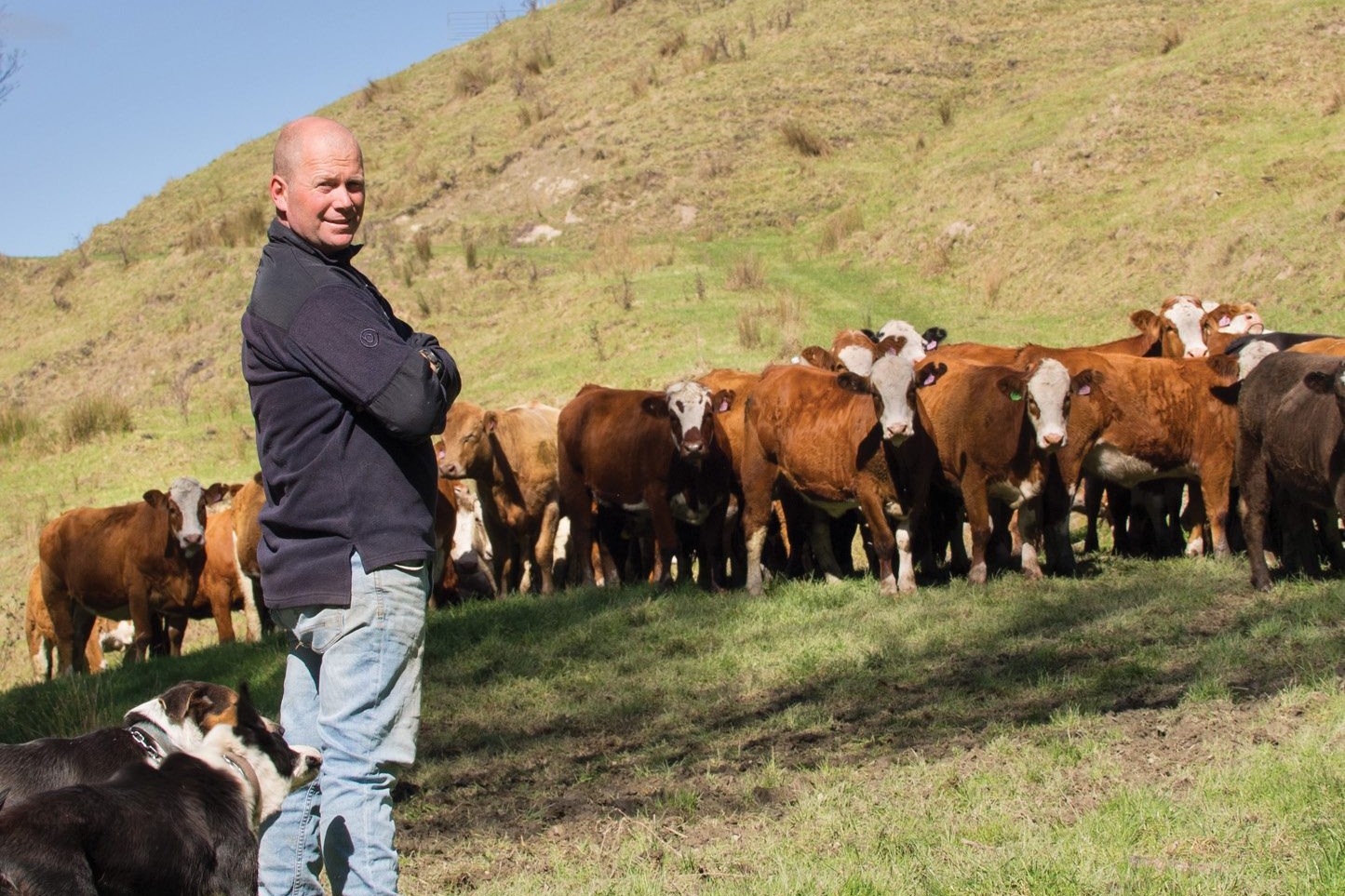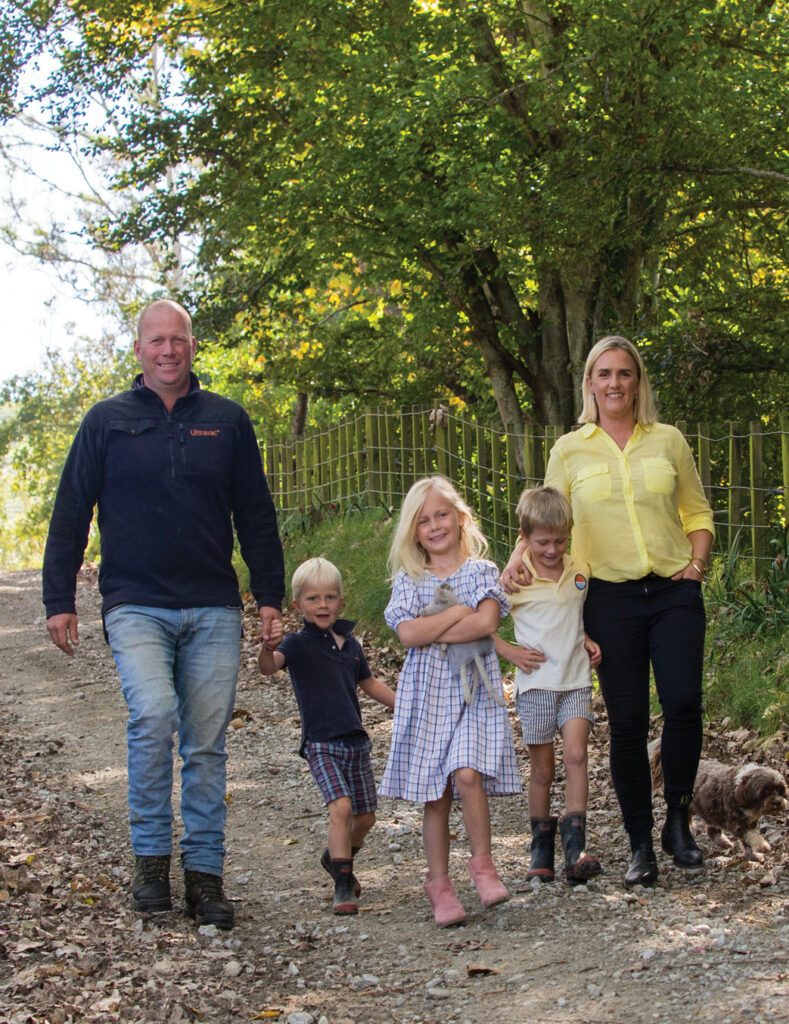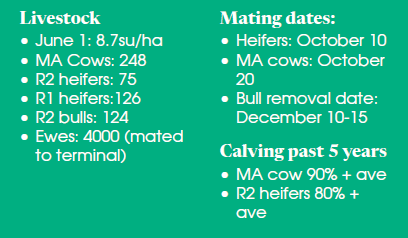Keeping the bulls growing
A target of a full Simmental herd is in the offing for the Kemps on their East Coast summer dry farm north of Gisborne. By Tony Leggett. Photos by Louise Savage.

A target of a full Simmental herd is in the offing for the Kemps on their East Coast summer dry farm north of Gisborne. By Tony Leggett. Photos by Louise Savage.
Fast early weight gain is vital to mitigate the risks from dry summer conditions for East Coast farmers Jeremy and Georgina Kemp.
The couple farm Pouriwai, 1025ha at Rere, 40km north of Gisborne, where droughts can hit anytime from late spring to the end of the summer.
Their systems for beef and lamb production are tuned to maximise early weight gain so stock can be slaughtered if pasture growth evaporates.
Their mixed-age cow herd of 230 head plus replacements is approaching full Simmental. This after the opportunity came up to buy a large number of commercial cows from nearby Gold Creek Simmental herd. They are also made a decision to breed back to Simmental after introducing Angus and Hereford-Friesian genetics several years ago.
“We’ve got about another two or three years left to breed back to a full Simmental herd and the plan is to increase the herd size to about 270 cows over that time,” Jeremy says.
Their herd includes cows from the now de-registered Pouriwai Charolais and Simmental studs set up by Jeremy’s father Gerald, now semi-retired and living near Gisborne.
A small number of herd bulls are sold to nearby farms and former Pouriwai stud clients, but the majority of male calves are left entire and finished to an average liveweight at slaughter between 630-640kg, mostly within 12-14 months of weaning.

Male calves typically wean at an average of about 280kg LW. They are sorted into groups of about 20 head each and usually spend up to the next 12 months on a five-seven-day rotation around 15-20ha of the farm’s 100ha of easier country.
A small amount of back-up balage is bought in to top up during any feed pinches but the farm has a reliable early August start to growing spring grass and the bulls (stocked at 1.6/ha) often graze their paddocks among ewes and lambs or weaned lambs.
“In a growthy spring, we will bring in mobs of cows to clean up paddocks so the bulls get moved out the way for a while as the cows come through.”
Depending on pasture growth and the season, the first of the bulls slaughtered usually average 660kg – an impressive 1+kg/day weight gain from weaning on pasture – and the aim is to get 50% killed by the end of January.
The heaviest four or five bulls from each mob are selected for slaughter, making room for another group to emerge at the top a few weeks later.
Jeremy says keeping the bulls growing right through the winter creates options if the season turns dry in spring or summer.
“We used to be hard on the commercial cattle through the winter and they would lose a bit of weight, and then we’d have a dry summer and it was always a battle to get them up to good weights for slaughter.
“I’ve found keeping fat on your cull cattle certainly increases the ability to get them to the weights we target with good yields.”
He is also content with running heavier breeding cows, because of their capacity to reliably wean heavy calves.

Cattle struggle in January heat
“The Simmental breed type is also different now. They are a lot more feminine these days, so fertility is very good and mature cow size has come back a bit.”
“I don’t mind having a big cow. We’ve had more bad years than good years and I like to know that I can get bulls through to January and they will be over 300kg on the hook when slaughtered,” he says.
“We get hot here in January and February and cattle struggle to add weight and then the cull dairy cow kill kicks in and the schedule can come back. That’s why having our bulls up to good weights before the end of year means we have options to hold or go early depending on feed and schedule.”
Other reasons to add more cattle is a looming battle with drench resistance in the sheep operation and a reduction to one full-time staff member after long-time stock manager Duncan Macpherson passed away. A logging company is also part-way through logging a large area of trees on the farm, meaning about a 20% of the farm has been opened up for access to remove the logs.
To maintain the winter stocking rate of 8.7 stock units/ha, an increase in cow numbers and more short-term cattle trading is likely.
The Kemps are mindful of the risks of carrying more, heavy cows through the winter and the impact on soil structure if it turns wet. However, they are confident the combination of 20% more cows and a likely heifer trade when seasons allow will be a comfortable compromise for fewer capital stock ewes.
“Heifers suit our operation better than trading steers, I think. The beauty of having the bulls away nice and early is that we can hold heifers on for longer if feed allows to target the export market.”

Margins vary depending on the option chosen for trade cattle, but the aim is to buy and take through to slaughter each time.
“As soon as I hit August, I know we’ll start to grow grass so the aim is to get any trade cattle in late June or July.”
Until this year, all the cattle were slaughtered through Greenlea Meats in Hamilton. But tightening space for East Coast cattle means the Kemps have switched to killing stock through Silver Fern Farms’ Hawke’s Bay plant.
“We always found Greenlea was ahead of the other companies on price by up to 20c/kg, but they are getting plenty of cattle from the Waikato region now, and it’s harder to get space” Jeremy says.
In the past few years, their ewe flock of 4000 has been mated entirely to terminal sires (Hampshires and Poll Dorsets) to boost their chance of getting lambs away at their target carcase weights (minimum 16.5kg) before drier weather sets in in mid-November. Mixed age ewes start lambing from August 12 and the aim is to achieve 40% of lambs killed prime at weaning 100 days later.
The remaining lambs graze the farm’s easier country and crops over the following months before slaughter at 18kg. Depending on seasonal conditions, the Kemps will buy in store lambs to finish.
This tupping, the Kemps have returned to using maternal rams in about 35% of the ewe flock after struggling to find suitable replacement two-tooths with the extra bone and structure they prefer, along with facial eczema tolerance. This will increase to 60% next year, reducing the impact on drench resistance from bought-in stock.




